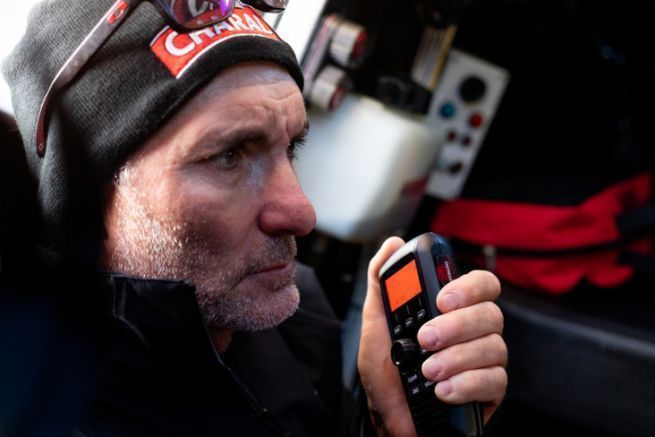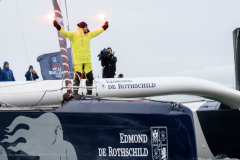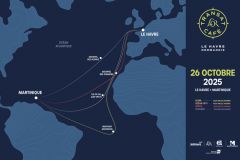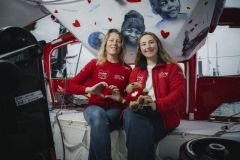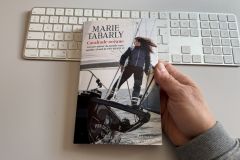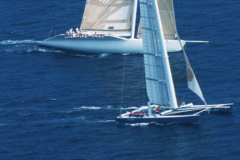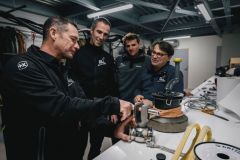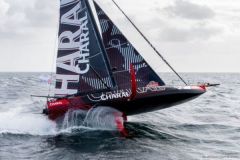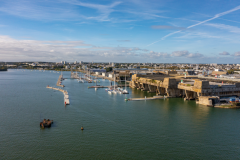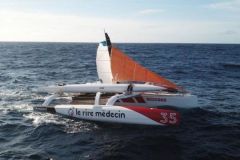With less than a month to go, what is your state of mind?
I really want to go back. I miss the competition. And I'm even happier to go back in doubles. It's a format I like. It often works well for me in this Transat Jacques Vabre. There is a way to pull on the boats. I'm still a bit disappointed with the Vendée Globe. We're sailing single-handed, isolated. You have to manage a lot. To find myself behind, with no competition, I sailed a little bit below what I could.
What are your ambitions for this Transat Jacques Vabre? Do you have any revenge to take after the Vendée Globe?
We hope to be in the fight to go at least as fast as the others. We want to be competitive, to go all out on this boat, which is just asking for it. We're going to try to get a very good result. I was deprived of one in the Vendée Globe and in my previous Jacques Vabre. We didn't finish as we wanted.
I really want to give it my all and get my revenge on the course. There are 2 boats that finished ahead of us in 2019. They sailed better than us. In sailing races, there are surprises, nothing can be taken for granted. We would like the scenario to turn in our favor this time.
Have you done a workcamp on Charal or will you be in the same configuration as before the world tour?
We made changes on the fringe. We have adapted to the new 2021-2025 rules. Our foils are in accordance with the new regulations, below 8m 3. We have also changed the mast rake to 6 degrees. These are more typical modifications for downwind sailing. The measurement measures are not going towards the ability of the boats to go fast upwind.
We forced the line for medium downwind sailing in strong winds. We distributed the weight on board and redid the bow, which helps us more in these conditions.
On these boats - which is what most of the competitors have - if you don't change the foils, you don't change the performance. So we have kept the same package as in the Vendée Globe because the boat is not bad as it is, but also because we are launching the construction of a new boat. Financially, as in the team, it is not possible to be on all subjects. In order to make money, we had to make big changes. We preferred small modifications with small guaranteed gains. We are not dissatisfied. We can see that the competition has progressed a lot. And so have we. We know our boat well and we control it well.
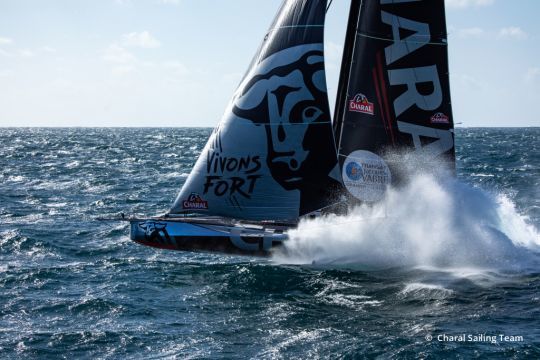
Where are you in the construction of your new boat and why did you choose a new architect?
It's a bit of a personal choice on my part. We continue to work with VPLP on Charal 1 and all the modifications we make on board. On this new boat, we wanted to have more autonomy in the team and do a lot of things in-house. We have strengthened the design office and found a kind of autonomous organization with Sam Manuard.
Without any value judgment, we consulted the best architects we could. But because of timing and internal organization, it was a good fit with Sam. He also has this avant-garde side, I think. Especially on L'Occitane. He has a vision of things and a marine sense. And the speech that goes with it really spoke to me. It's an organizational and human choice.
I am not disappointed in the way it has worked since the beginning of the design. The relationship I have with Sam and his team at KNDmarine, with Dimitri Nicolopoulos. They have their convictions and their way of seeing things while accepting and being interested in questioning them. Internally, our design office is full of ideas. We have requests and points of view that are sometimes different from Sam and KND, but we work well together. There are some very interesting things coming out.
In every double-handed race, you sail with Christopher Pratt. Who is he for you and what are the assets of your pairing ?
He's my double-handed crew member. Just like in dinghy sailing. I don't change my teammate every year or two. It's something we both do. We made this choice at the beginning of the Charal campaign, since the boat was launched.
We did the 1st Jacques Vabre and all the double-handed races that followed on this boat. It works well, we are used to it. We are progressing together and we share the same vision of things. There is a lot of turnover in the crews.
In the Olympics, when you start a campaign with a coxswain and a crew member, you change quickly if it doesn't work out or you keep the pair for at least 4 years. There is so much to gain by perfecting your relationship and your knowledge of the sport. You progress compared to the competition. We get along well at sea and on land.
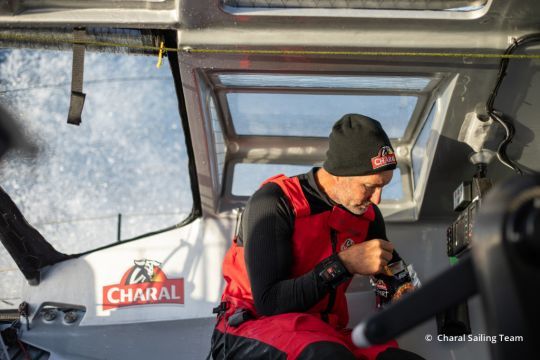
What are the constraints and advantages of a double-handed race format compared to solo or crewed racing?
It's not easier in terms of organization. It's more complicated in terms of sleep and rest management I think. When you are solo, you can sleep when you want, eat when you want, do your maneuvers when you feel like it. When you are double-handed, you have to manage your own fatigue and your own personal management and cohabit with the needs of the other. The exercise is not easy. We try to be as flexible as possible. With Christopher, we don't have a set schedule, duration or shifts. When one is tired, so is the other. At the beginning of the race, it falls at the same time. Even though I'm more of an evening person and he's a morning person. In my opinion, from an organizational point of view, it's easier solo.
When it comes to comparing points of view, especially strategic ones, two people are more intelligent than one. When someone can keep a daily watch, you can pull 100% on the boat all the time. You can go as fast double-handed as with a crew or single-handed, even if in the latter case, the average is not as good.
In the Vendée Globe, there was no huge average speed, although these boats have the potential to do so. In a double-handed race, the average speed is more important. What we need is a double-handed round the world race. We'll be able to achieve good averages over at least 12 hours.
What do you think of the new race courses? What will it change? Knowing the experience you had two years ago in the doldrums?
I like to go south, to go around the high, on a classic Route du Rhum type course. Even if there is the doldrums at the end of the straight. That's part of the game. Sometimes you get trapped, sometimes it goes better. It's a matter of luck and you have to deal with it. Last time it wasn't for us and it might be again this year. There are no rules.
I like to arrive in Brazil, I like the Brazilians, the atmosphere... On this new course, the new end is interesting. There are not many people who know this section in this sense, after a sequence in the south. It's going to be sport all the way to the end, with strong wind and downwind conditions. Our boats are not easy at this speed. There may be some upheaval at least if the boats are struggling, with strong or medium wind downwind or on an open reach. It's going to be very demanding compared to the previous edition.
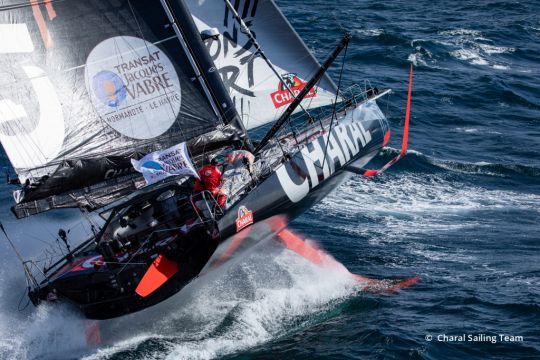
How do you feel about the competition, both in personal and material terms (boat)?
The class has homogenized upwards. Each time, it progresses. In the previous edition, we were better than the rest of the fleet. That has faded as the other teams have grown. They have sailed and discovered their boat. We know that Apivia is doing well, as well as LinkedOut, the two 11 th Hour Eleven, Arkéa Paprec... There are a lot of clients. That's what's interesting.
In terms of performance, they are a little bit faster than us. But in terms of pure performance, in the last edition, we were the best. That can't stop us from winning. With Christopher, we're gaining in intensity, we're going to hit the boat, the men. We're not going to hesitate to take more risks than usual and not let ourselves be taken advantage of.
After the Transat Jacques Vabre, what are your plans?
Everything will happen quickly. We're going to bring the boat back to Lorient by sea and take her out in December for a quick refit and a return to the water at the beginning of March. We'll be preparing for the pre-season races: Bermuda 1000, Vendée Arctique... In parallel, we're making progress on the construction of the new boat. We're going to fit the fittings on Charal 2. The vacations will be short!
